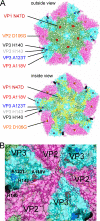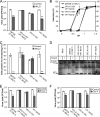A single amino acid substitution in the capsid of foot-and-mouth disease virus can increase acid lability and confer resistance to acid-dependent uncoating inhibition
- PMID: 20053737
- PMCID: PMC2826036
- DOI: 10.1128/JVI.02311-09
A single amino acid substitution in the capsid of foot-and-mouth disease virus can increase acid lability and confer resistance to acid-dependent uncoating inhibition
Abstract
The acid-dependent disassembly of foot-and-mouth disease virus (FMDV) is required for viral RNA release from endosomes to initiate replication. Although the FMDV capsid disassembles at acid pH, mutants escaping inhibition by NH(4)Cl of endosomal acidification were found to constitute about 10% of the viruses recovered from BHK-21 cells infected with FMDV C-S8c1. For three of these mutants, the degree of NH(4)Cl resistance correlated with the sensitivity of the virion to acid-induced inactivation of its infectivity. Capsid sequencing revealed the presence in each of these mutants of a different amino acid substitution (VP3 A123T, VP3 A118V, and VP2 D106G) that affected a highly conserved residue among FMDVs located close to the capsid interpentameric interfaces. These residues may be involved in the modulation of the acid-induced dissociation of the FMDV capsid. The substitution VP3 A118V present in mutant c2 was sufficient to confer full resistance to NH(4)Cl and concanamycin A (a V-ATPase inhibitor that blocks endosomal acidification) as well as to increase the acid sensitivity of the virion to an extent similar to that exhibited by mutant c2 relative to the sensitivity of the parental virus C-S8c1. In addition, the increased propensity to dissociation into pentameric subunits of virions bearing substitution VP3 A118V indicates that this replacement also facilitates the dissociation of the FMDV capsid.
Figures







Similar articles
-
The pH stability of foot-and-mouth disease virus.Virol J. 2017 Nov 28;14(1):233. doi: 10.1186/s12985-017-0897-z. Virol J. 2017. PMID: 29183342 Free PMC article. Review.
-
The pH Stability of Foot-and-Mouth Disease Virus Particles Is Modulated by Residues Located at the Pentameric Interface and in the N Terminus of VP1.J Virol. 2015 May;89(10):5633-42. doi: 10.1128/JVI.03358-14. Epub 2015 Mar 11. J Virol. 2015. PMID: 25762735 Free PMC article.
-
Engineering Responses to Amino Acid Substitutions in the VP0- and VP3-Coding Regions of PanAsia-1 Strains of Foot-and-Mouth Disease Virus Serotype O.J Virol. 2019 Mar 21;93(7):e02278-18. doi: 10.1128/JVI.02278-18. Print 2019 Apr 1. J Virol. 2019. PMID: 30700601 Free PMC article.
-
A single amino acid substitution in the capsid of foot-and-mouth disease virus can increase acid resistance.J Virol. 2011 Mar;85(6):2733-40. doi: 10.1128/JVI.02245-10. Epub 2010 Dec 22. J Virol. 2011. PMID: 21177816 Free PMC article.
-
Cell Culture Adaptive Amino Acid Substitutions in FMDV Structural Proteins: A Key Mechanism for Altered Receptor Tropism.Viruses. 2024 Mar 27;16(4):512. doi: 10.3390/v16040512. Viruses. 2024. PMID: 38675855 Free PMC article. Review.
Cited by
-
Production of a Foot-and-Mouth Disease Vaccine Antigen Using Suspension-Adapted BHK-21 Cells in a Bioreactor.Vaccines (Basel). 2021 May 13;9(5):505. doi: 10.3390/vaccines9050505. Vaccines (Basel). 2021. PMID: 34068378 Free PMC article.
-
A Heat-Induced Mutation on VP1 of Foot-and-Mouth Disease Virus Serotype O Enhanced Capsid Stability and Immunogenicity.J Virol. 2021 Jul 26;95(16):e0017721. doi: 10.1128/JVI.00177-21. Epub 2021 Jul 26. J Virol. 2021. PMID: 34011545 Free PMC article.
-
Single amino acid substitution of VP1 N17D or VP2 H145Y confers acid-resistant phenotype of type Asia1 foot-and-mouth disease virus.Virol Sin. 2014 Apr;29(2):103-11. doi: 10.1007/s12250-014-3426-x. Epub 2014 Mar 26. Virol Sin. 2014. PMID: 24752763 Free PMC article.
-
Adaption of FMDV Asia-1 to Suspension Culture: Cell Resistance Is Overcome by Virus Capsid Alterations.Viruses. 2017 Aug 18;9(8):231. doi: 10.3390/v9080231. Viruses. 2017. PMID: 28820470 Free PMC article.
-
The pH stability of foot-and-mouth disease virus.Virol J. 2017 Nov 28;14(1):233. doi: 10.1186/s12985-017-0897-z. Virol J. 2017. PMID: 29183342 Free PMC article. Review.
References
-
- Acharya, R., E. Fry, D. Stuart, G. Fox, D. Rowlands, and F. Brown. 1989. The three-dimensional structure of foot-and-mouth disease virus at 2.9 A resolution. Nature 337:709-716. - PubMed
-
- Baxt, B. 1987. Effect of lysosomotropic compounds on early events in foot-and-mouth disease virus replication. Virus Res. 7:257-271. - PubMed
Publication types
MeSH terms
Substances
LinkOut - more resources
Full Text Sources
Miscellaneous

